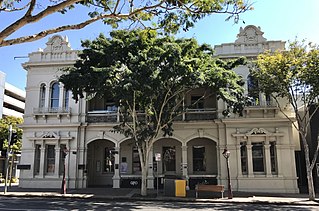
Regatta Hotel is a heritage-listed hotel at 543 Coronation Drive on the corner of Sylvan Road, Toowong, City of Brisbane, Queensland, Australia. It faces the Toowong Reach of the Brisbane River and was named after the rowing regattas held there. It was designed by Richard Gailey and built in 1886 by George Gazzard. It was added to the Queensland Heritage Register on 21 October 1992.

McWhirters is a heritage-listed former department store at Wickham Street, Fortitude Valley, City of Brisbane, Queensland, Australia. It is also known as McWhirters Marketplace, McWhirters & Son Ltd, and Myer. It was added to the Queensland Heritage Register on 21 October 1992.

The Orient Hotel is a heritage-listed hotel at 560 Queen Street, Brisbane CBD, City of Brisbane, Queensland, Australia, on the corner of Ann Street. It was originally built as the Excelsior Hotel in 1875 and extended in 1884, both of which were designed by Brisbane architect Richard Gailey. It was added to the Queensland Heritage Register on 23 April 1999.

Exchange Hotel is a heritage-listed hotel at 134-138 Patrick Street, Laidley, Lockyer Valley Region, Queensland, Australia. It was designed by Eaton & Bates and built in 1902. It was added to the Queensland Heritage Register on 21 October 1992.

Wickham Hotel is a heritage-listed hotel at 308 Wickham Street, Fortitude Valley, City of Brisbane, Queensland, Australia. Originally trading as the Oriental, it was designed by Richard Gailey and built in 1885 by Cussack & O'Keefe. It was added to the Queensland Heritage Register on 21 October 1992.

Prince Consort Hotel is a heritage-listed hotel at 230 Wickham Street, Fortitude Valley, City of Brisbane, Queensland, Australia. It was designed by Richard Gailey and built from 1887 to 1888 with later extensions. It was added to the Queensland Heritage Register on 21 October 1992. In 2014, it is trading as the Elephant Hotel.

Jubilee Hotel is a heritage-listed hotel at 464–468 St Pauls Terrace, Fortitude Valley, City of Brisbane, Queensland, Australia. It was designed by Richard Gailey and built from 1887 to 1888. It was added to the Queensland Heritage Register on 21 October 1992.

Holy Trinity Rectory is a heritage-listed Anglican clergy house at 141 Brookes Street, Fortitude Valley, City of Brisbane, Queensland, Australia. It was designed by Francis Drummond Greville Stanley and built in 1889 by James Robinson. It was added to the Queensland Heritage Register on 21 October 1992.

Beth-Eden is a heritage-listed villa at 85 Bank Road, Graceville, City of Brisbane, Queensland, Australia. It was designed by Richard Gailey and built from 1888 to 1910s. It is also known as Rakeevan and Verney. It was added to the Queensland Heritage Register on 21 October 1992.

Coronation Hotel is a heritage-listed hotel at 46 Montague Road, South Brisbane, Queensland, Australia. It was designed by Francis Drummond Greville Stanley and built in 1891. It is also known as Montague Hotel. It was added to the Queensland Heritage Register on 30 April 1993.

Taylor–Heaslop Building is a heritage-listed commercial building at 10-14 Logan Road, Woolloongabba, City of Brisbane, Queensland, Australia. It was designed by John Beauchamp Nicholson and built from 1889 to 1890. It is also known as Ernest Reid (draper), John Evan's Cash Draper, George Logan Draper, Johns & Co Draper, People's Cash Store (grocers), JR Blane, and Moreton Rubber Works. It was added to the Queensland Heritage Register on 6 February 2006.

The Phoenix Buildings are heritage-listed commercial buildings at 647 Stanley Street, Woolloongabba, City of Brisbane, Queensland, Australia. They were designed by Richard Gailey and built from 1889 to 1890 by James Rix. They were added to the Queensland Heritage Register on 24 May 1995.

Fortitude Valley Police Station is a heritage-listed police station at 119 Brookes Street, Fortitude Valley, City of Brisbane, Queensland, Australia. It was designed by Raymond Clare Nowland and built from 1935 to 1936. It was added to the Queensland Heritage Register on 24 June 1999.

Fortitude Valley Post Office is a heritage-listed former post office at 740 Ann Street, Fortitude Valley, City of Brisbane, Queensland, Australia. It was designed by Colonial Architect's Office and built in 1887 by William Ferguson. It is also known as Fortitude Valley Post & Telegraph Office. It was added to the Queensland Heritage Register on 24 January 2003.

Royal George Hotel and Ruddle's Building is a heritage-listed hotel at 323–335 Brunswick Street, Fortitude Valley, City of Brisbane, Queensland, Australia. It was built from c. 1850 to the 1960s. It is also known as Bush & Commercial Inn, Commercial Inn, Freemasons Arms, and Ruddle's Corner. It was added to the Queensland Heritage Register on 3 August 1998.

La Scala is a heritage-listed detached house at 517 Brunswick Street, Fortitude Valley, City of Brisbane, Queensland, Australia. It was designed by Thomas Ramsay Hall and built c. 1915. It was originally known as Craig Athol. It was added to the Queensland Heritage Register on 21 October 1992.

Transcontinental Hotel is a heritage-listed hotel at 462-468 George Street, Brisbane City, City of Brisbane, Queensland, Australia. It was designed by Francis Drummond Greville Stanley and built from 1883 to 1884. It was added to the Queensland Heritage Register on 21 October 1992.

Hotel Metropole is a heritage-listed hotel at 253 Brisbane Street, West Ipswich, City of Ipswich, Queensland, Australia. It was designed by George Brockwell Gill and built in 1906. It was added to the Queensland Heritage Register on 21 October 1992.

Ulster Hotel is a heritage-listed hotel at 25 Brisbane Street, Ipswich, City of Ipswich, Queensland, Australia. It was built in 1910. It was added to the Queensland Heritage Register on 21 October 1992.
Post Office Hotel is a heritage-listed hotel at Bazaar Street, Maryborough, Fraser Coast Region, Queensland, Australia. It was designed by Victor Emmanuel Carandini and built in 1889 by Mr Murray. It was added to the Queensland Heritage Register on 21 October 1992.






















